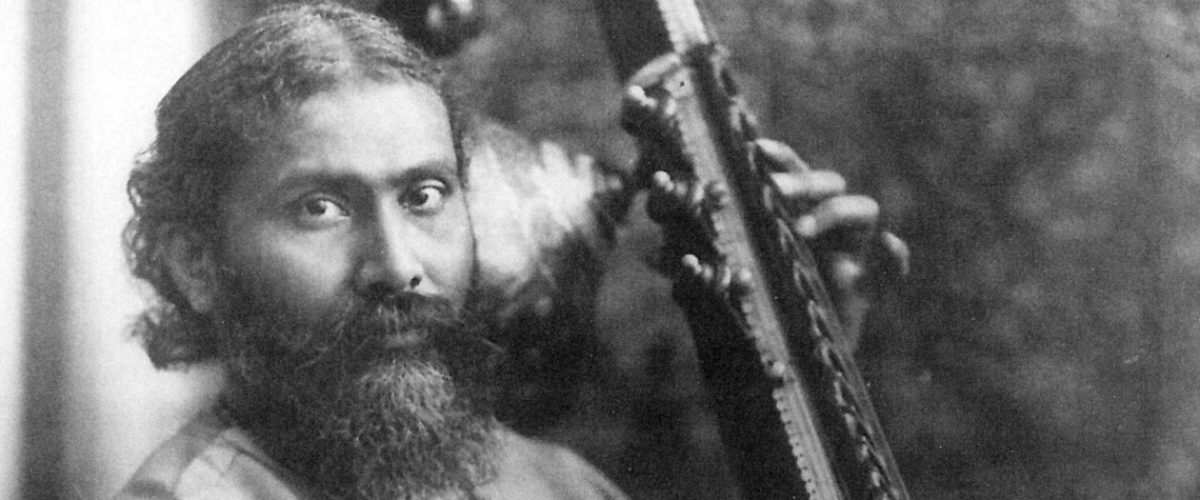

One of the 20th century’s greatest musicians, the widely influential Sufi master Inayat Khan (1882-1927) was born into a family of famous musicians in Baroda. Yet his name has all but lapsed from India’s collective musical memory. His father Rahmat Khan, sang Dhrupad whilst his maternal grandfather, Maula Bakhsh was a highly respected veena player who founded India’s first music academy. They taught North and South Indian as well as Western music to both boys and girls, and taught their young progeny.
At the age of 25, Inayat had already written and published a treatise in Urdu, Minqar-e-Mosiqar, (now out of print) on a huge sweep of aspects from Indian music and dance, detailing the technique of some 500 different raags and including notated compositions (with notations) for dhrupad, khayal, ghazal, and thumri forms of music. Although primarily a veena player, he was equally accomplished on a number of string instruments as well as the tabla, violin, cello, and piano. He was also a vocalist of tremendous ability in both dhrupad and khayal. Recordings of 31 of his songs have miraculously survived intact from a session in Kolkata in 1903, with his musical prowess easily overcoming the rather poor technical quality of the recordings.
India may be forgiven for forgetting Inayat Khan the musician, because in 1911, at the zenith of his fame, he left his homeland to travel the West. First going to America and Britain and travelling widely throughout Europe, he finally settled in France, with the specific aim of introducing Westerners to Indian classical music. But he was some 50 years too early and although the West had developed a new fascination for all things ‘Oriental’, India’s ancient classical music was still an unknown quantity. Inayat, who had been a court musician for the Nizam of Hyderabad (who had crowned him 'Tansen') and enjoyed widespread recognition as a young beenkar (veena player), was at a loss to understand why British and European courts had no equivalent tradition of resident classical musicians.
In pre-World War I Europe, Indian classical music assignments were rather thin on the ground and, to make ends meet, Inayat often ended up accompanying some kind of fake ‘Oriental’ dance, including that of the notorious Mata Hari and the famous American dancer, Ruth St. Denis. Even so, he did perform pure classical music at many private gatherings and his music was greatly appreciated by the Tsar of Russia in 1913, at whose court he also met the Russian composer Alexander Scriabin, who became a disciple.
Contemporary records, specifically the writings of eccentric Italian author Gabriele D’Annunzio, contain a vivid and evocative record of the striking impression made by Inayat's singing. The French composer Claude Debussy also studied with him, and the influence of Indian classical music is evident in much of his later work. But, for Inayat, music was primarily a spiritual practice and his objective as a musician was to connect to a larger reality and to "tune in to the music of the spheres".
After 16 years away, he revisited India in 1926 where, in early 1927, aged 45, he succumbed to pneumonia. He leaves behind a vast body of work – his teachings meticulously transcribed by disciples – and his groundbreaking treatsie Mysticism of Sound and Music (1921) has yet to be surpassed. His European descendants all became musicians of Western classical music whilst his daughter, Noorunissa Inayat Khan (also a musician), was shot by the Nazis in 1944 and remains a celebrated heroine of the French Resistance.
Speaking about his music, he has said: "I am as His flute – He may play me whenever He chooses". As the number of his spiritual disciples grew all over the Western world he gradually stopped performing music saying: "Instead of tuning instruments, I now tune human souls". He lies buried in Delhi, in the vicinity of the tomb of the 13th century Sufi master Hazrat Nizamuddin Awliya, and his grave attracts several thousand followers, mostly European and American, every year.
Listen to the music | A rare recording of Hazrat Inayat Khan singing spiritual music to his followers in 1909.
Jameela Siddiqi is an author, linguist, and BBC cultural commentator, specialising in postcolonial fiction and the devotional music of South Asia.
Darbar believes in the power of Indian classical music to stir, thrill, and inspire. Explore our YouTube channel, or subscribe to the Darbar Concert Hall to watch extended festival performances, talk and documentaries in pristine HD and UHD quality.
Darbar believe in the power of the Indian classical arts to thrill, stir and inspire a global audience. But what does...
Read More 
The beginner's guide to Indian classical music. Whether you’re completely new to raga music or just need a refresher, we’ve put together this brief overview of all things raga music to help you feel at ease when visiting one of our concerts or watch our videos on our YouTube or our Darbar Concert Hall.
Keep up to date with the latest news, events, music and musings across our social channels
For hundreds more clips and shorts, vist our YT page here 